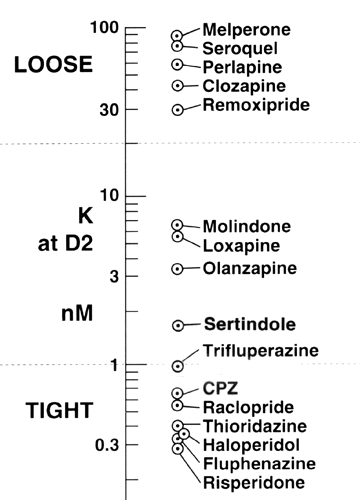
| Figure 3. |
 |
| According to the values for the radioligand-independent dissociation constants in Table 3, antipsychotic drugs fall into three groups. The traditional antipsychotic drugs (haloperidol, fluphenazine, thioridazine, chlorpromazine and trifluoperazine) all have dissociation constants below 1 nM, indicating that they bind very tightly to the dopamine D2 receptor. These drugs readily elicit Parkinsonism in patients. The antipsychotic drugs with very high dissociation constants, between 30 nM and 100 nM, bind very loosely to the dopamine D2 receptor, and these are the atypical antipsychotic compounds which cause little or no Parkinsonism. The intermediate group of antipsychotic drugs (molindone, loxapine, olanzapine and sertindole) have radioligand-independent dissociation constants close to the dissociation constant of 2–7 nM for dopamine at the high-affinity state of D2. These compounds, therefore, elicit a mild amount of Parkinsonism which is dependent on the antipsychotic dose used. In other words, the antipsychotic drugs that bind more tightly than dopamine all elicit Parkinsonism, while those that bind much more loosely than dopamine elicit almost no Parkinsonism, and those which bind with an avidity similar to that of dopamine may cause only moderate or low levels of Parkinsonism. |
published 2000